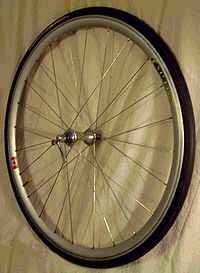
Photo from wikipedia
Abstract Two web compression buckling capacity prediction methods are introduced for unstiffened steel I-sections subject to opposite patch loading applied to the flanges. The methods are generally posed as a… Click to show full abstract
Abstract Two web compression buckling capacity prediction methods are introduced for unstiffened steel I-sections subject to opposite patch loading applied to the flanges. The methods are generally posed as a function of loaded width to web depth ratio, and are applicable for opposite patch loading applied at the interior of a wide flange section or at the end of it, where the web has a free edge. The proposed methods include three parts: 1) an expression for predicting the squash load, 2) an expression for predicting the elastic buckling load, and 3) a resistance function. The squash load is calculated using an empirically derived effective width concept based on observations at the ultimate load from an extensive experimental database and validated numerical simulations. Web slenderness is defined as the square root of the ratio of the web squash load to the web critical elastic buckling load. The critical elastic buckling load is defined consistently with that obtained with a plate buckling energy solution for patch loading on infinitely long strips and considers the shortened web buckling half-wavelength resulting from flange rotational restraint provided to the web. The methods are validated with existing experimental data and shell finite element collapse simulations, and are shown to be more accurate and more widely applicable than current American Institute for Steel Construction (AISC) Specification provisions.
Journal Title: Journal of Constructional Steel Research
Year Published: 2019
Link to full text (if available)
Share on Social Media: Sign Up to like & get
recommendations!